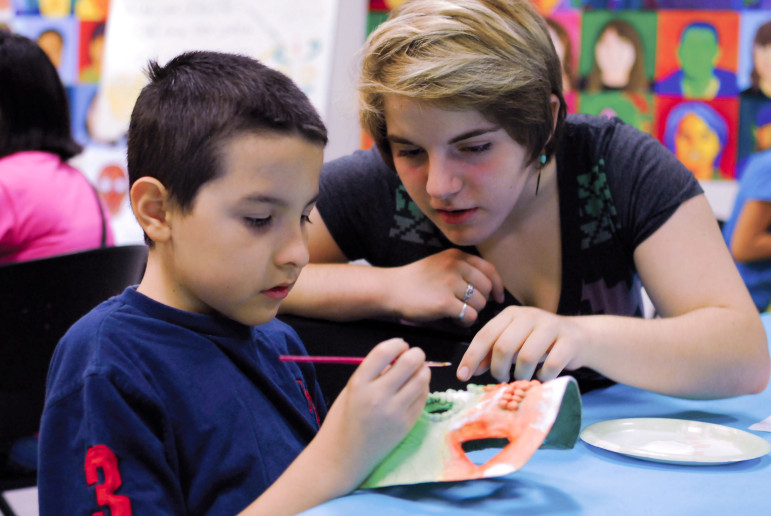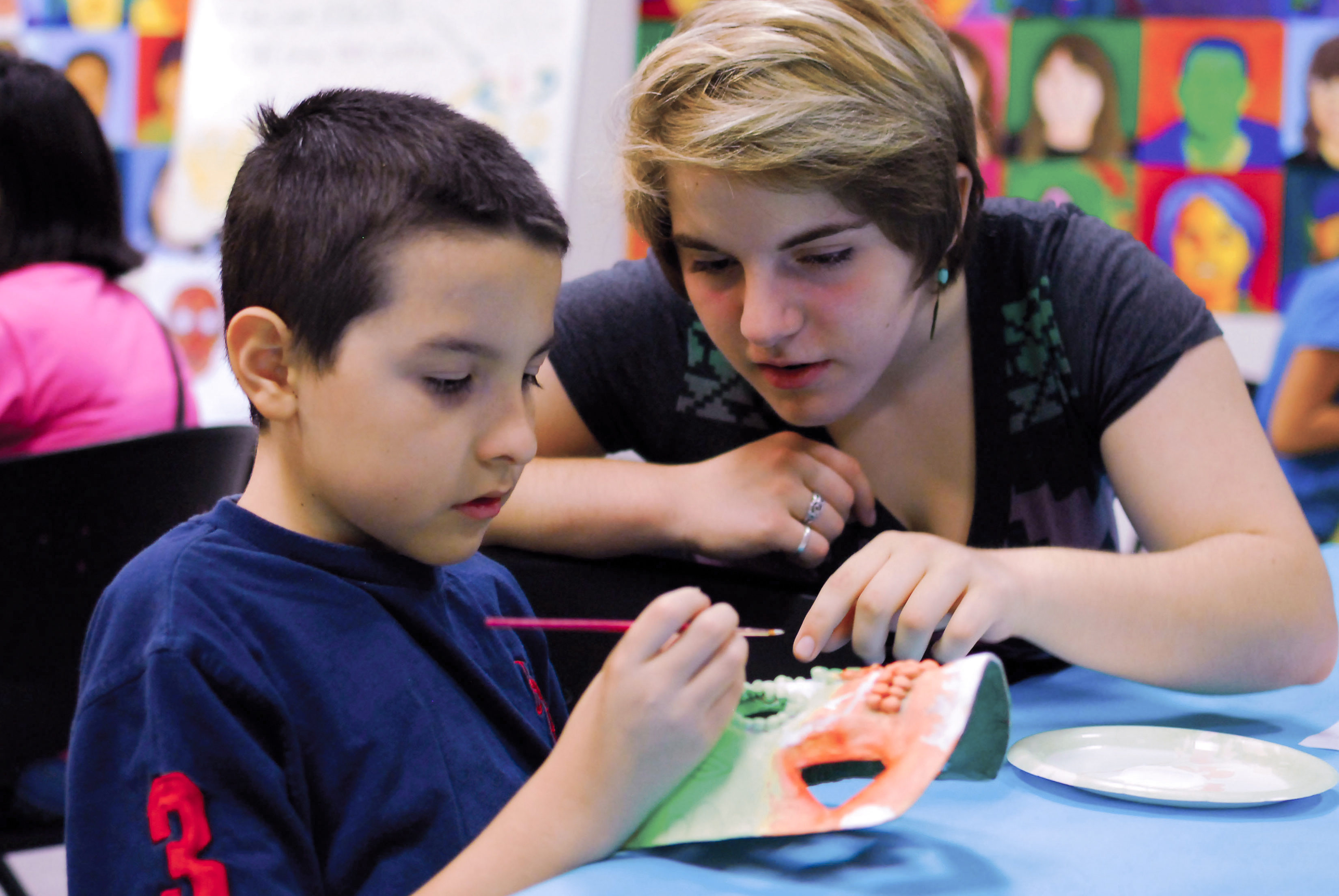
SAY Sí
An artist-mentor works with a young student on an art project at SAY Sí in San Antonio, Texas.
Ten middle school kids sit in a semicircle around musician Bruce Andrews, each holding a harmonica. They lean forward on their hard metal chairs to listen and watch closely as he plays a few bars.
Andrews is a blues musician, and the children know it. He brings some of the magic of real world songwriting and performing into the room — along with the daring idea of baring your soul through music.
“Come on, you can do it,” he says encouragingly, as each youngster takes a turn sucking in air through the harmonica and making it wail.
Here at the Alabama Blues Project camp, in Tuscaloosa, Ala., 50 kids are drawn in by real-world musicians, who give them immediate hands-on experiences with the art of music. The kids find a supportive environment where they can make new friends, and they get to show what they’ve learned at a performance at the end of the weeklong camp, just what middle school kids say they want, according to a report released in November by the Wallace Foundation, which studied ways to attract low-income, middle-school age youth to arts programs. The Wallace Foundation used a market research firm to conduct focus groups and interviews with kids and their parents.
“Engagement in the arts not only allows young people to express themselves and unleash the power of their imaginations, but also can build skills and confidence,” wrote the foundation president, Will Miller.
The decline of arts
Arts programs in schools have been in a steady decline, not just in recent years but in the past three decades, according to a 2008 RAND Corp. study commissioned by the Wallace Foundation. The focus on testing in schools has led to a decrease in arts activities, like band and drama, but the dropoff started well before that, the study reported, with budget cuts in the 1970s and ‘80s.
Outside of school, arts programs exist, but low-income children are less likely to take part in them.
A U.S. Census survey in 2009 found that in families with household incomes of $72,000, 38 to 44 percent of kids were enrolled in lessons, clubs or sports after school. Among the lowest-income families, those with $18,000 or less, fewer than 20 percent of kids took part in such activities.
In addition, the middle school years are a time when kids’ participation drops in out of school arts programs, said Peter Rogovin, coauthor of the Wallace report and founder and managing director of Next Level Strategic Marketing Group. Kids this age have more distractions, he said, and programs that work for younger children no longer draw middle and high school youth.
Asking the kids
The arts, however, have been shown to be valuable for kids of all ages.
“We think that arts education provides essential skills and perspectives,” said Lucas Held, the Wallace Foundation’s communications director. Kids who take part in arts programs gain a wider view and greater insight. They have greater success in school, said Held. They learn persistence and teamwork — and they learn how to learn.
The foundation’s research had a two-pronged approach. Researchers surveyed literature, interviewed 22 youth development academics and administrators, and conducted case studies of eight arts organizations.
And they also asked youngsters what they wanted. Researchers gathered information from six parent groups and 200 kids in focus groups in five cities across the country.
Kids identified five best practices for effective out-of-school arts programming:
- Real-world artists
- Immediate hands-on experiences
- Friendly environment
- Opportunity to showcase their work
- Incentives, such as snacks and T-shirts.
The young people’s desires matched well with what the experts said programs should offer. The end result of the research was 10 principles for successful afterschool arts programs. (See page 13.)
Research proves positive outcomes
Much research has shown that participation in the arts is beneficial. The Arts Education Partnership, a division of the Council of State School Chief Officers, summarized some of the research: Music instruction can improve math skills, and drama improves reading skills. Involvement in the arts develops critical thinking, such as comparing, critiquing and exploring multiple viewpoints. Arts programming engages kids and motivates them to learn, according to the Arts Education Partnership, providing them a way to connect knowledge with personal experience. When young actors mastered scripts in order to perform them, they reported they were better able to understand texts, according to “Highlights from Key National Research on Arts Education,” a summary of the Americans for the Arts’ national public education campaign. Certain kinds of music instruction improve spatial reasoning, according to studies cited in “Critical Links: Learning in the Arts and Student Academic and Social Development,” published by the Arts Education Partnership in 2002. An issue brief from the American Music Conference pointed out that high school music students had higher scores on the verbal and math SAT than students who had no music classes or experience. And a 2012 study prepared for the National Endowment for the Arts showed that students with high levels of arts involvement were less likely to drop out of school. With data from 25,000 students, the study, “The Arts and Achievement in At-Risk Youth: Findings from Longitudinal Studies,” showed higher academic performance across all socioeconomic levels for students who participated in the arts. But for many kids, the overriding reason is that art changes their lives for the better. “Art has changed my life because I’ve found something that I love to do,” said Alejandra Salazar, a student at SAY Si, a multifaceted, free afterschool program in San Antonio, Texas. “I’ve gotten the chance to learn so much about film and photography and graphic design, and that’s really important to me.”
See related article “After-school Arts Program Success.”
Financial supporters of Youth Today may be quoted or mentioned in our stories. They may also be the subjects of our stories.
































